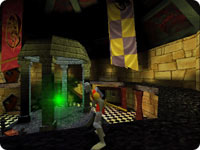
|
Page 1 | 2 |
Steve Parsons and his development team at Dragonstone Software had an epiphany one day.
They were working on a game that was an update of a classic, tirelessly trying to figure out how to retain the original look and feel of the main character. This mighty hero was originally rendered in 2D, but now needed to come alive in 3D, where gamers would be able to fully explore the world around them.
They toyed with making him look 3D, but that didn’t look right. It wasn’t until they took the 3D version and shaded him to make him look like a 2D character that the lightbulbs went on over their heads.

Game over.

Puzzle solving.
|
Parsons recalls: “Everyone’s eyes popped open and we said ‘This is Dragon’s Lair!’ This then became the primary rule in creating Dragon’s Lair 3D: if it doesn’t have the look and feel of the original, we didn’t use it.”
The Same But Different Who was that character? Dirk the Daring, of course, and the original Dragon’s Lair was a pioneer in the arcades Cinematronics published it in 1983. While it wasn’t the first laserdisc-based game (Astron Belt appeared earlier), it did have a very high profile, thanks to the involvement of Don Bluth, the animator best known for such films as The Secret of NIHM and An American Tail. |
![...if it doesn't have the look and feel of the original [Dragon's Lair], we didn't use it.](http://bradcook.net/games/articles/2001/04/dragons_lair/images/dragonslairquote1.gif)
Old Friends
Bluth and his partner Gary Goldman returned to assist the team, offering an original 2D opening animation sequence, a dozen new monsters (there are over 30 in the game), and access to the archive of Dragon’s Lair materials from the original game.
“We noticed that there isn’t enough original material from the arcade game that will convert to a 3D realm to create a full videogame,” says Parsons. “So, with Don Bluth and Gary Goldman’s help, we created additional areas and creatures that have filled in the adventure quite nicely. The gameplay we selected was similar to the original arcade game, with fast-paced arcade action, but we also added some puzzles and mini-quests to balance it out.”
Not only did the development team get help from Bluth and Goldman, but plenty of rabid Dragon’s Lair gamers wanted to provide input too.
“One fan even sent us a videotape of the original laserdisc to make sure we had some game sequences operating correctly,” Parsons recalls.
Three Ways to Play
Also returning from the original game is the option to play it in a simpler style. In the arcade game, you used a joystick and a button. Animation played on the screen before you, and at certain moments in the action you had to press the button or push the joystick in a certain direction to escape a trap or slay an enemy. One wrong move and you were dead.